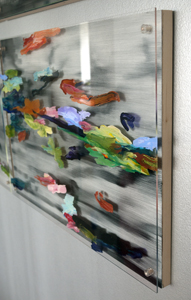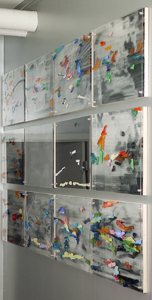KinoBlink
In art, as in science, and our everyday lives, we constantly extract samples
from the flow of experience and rearrange them in meaningful patterns. In
his 1994 film Anna, Russian director Nikita Mikhalkov samples his
daughter’s life. Only one day a year, for twelve consecutive years, he asks
her a set of five identical questions (what do you love the most? hate the
most? fear the most? want most? what are you most looking forward to?).
He then juxtaposes this selected sample of her growing up with a selection
of documentary footage showing the concurrently occurring break-up of the
USSR. Extraction is an alchemical process of getting at essences. Film editing
is the combinatorial alchemy of using extracts to build other realities.
While editing Coppola’s The Conversation, Walter Murch discovered
that we edit our experience by blinking. This is how our brain edits the
stream of visual input from our eyes, but we also blink when we finish one
thought and cut to the next one.
I used the editor in my brain to select frames from Mikhalkov’s Anna.
Whenever I blinked while watching the film, I extracted a frame. This sequence
of extracted frames is then a sample of the film that I literally did not
see – my idiosyncratic “black matter” taken from the already highly selected
universe of Anna. Such frame sequences are painted onto twelve
18in x 24in boards – one for each of Anna’s twelve years.
The number of frames extracted from each year is approximately 70. Those
frames that deal with documentary images are blended together for each year
and painted on the board in black and white. With the frames showing Anna
I use the blink of my eye as a camera shutter. I look at these frames for
a very short period of time, then blink and paint what was retained in my
memory as the most essential on the plexiglas that is mounted over the board.
In this way I let my brain do its own extracting of what it perceives as
the most essential in each frame. The whole series of twelve boards with
plexiglas is my transposition of the entire film filtered by my own blink-editing.
Mikhalkov’s Anna has been selected for a number of reasons. Thematically,
a young girl’s take on her country’s upheaval closely mirrors my personal
experience of Yugoslavia’s disintegration. I find strong affinities between
Anna’s changing attitudes towards her socialist homeland and my own, and
even with our respective life trajectories. Formally, I am fascinated with
temporal processes and ways that changes that are ordinarily imperceptible
could be made perceptible, striking and strange by artistic means.
I experimented with this sharpening of overlooked temporalities by extreme temporal contraction in Edmonton 24, or dilation (extreme slowing down of fleeting movements) in Art Under Siege.













